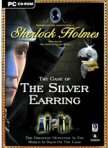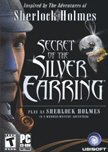Sherlock Holmes
is one of the most recognizable characters in English culture. The
original books by Sir Arthur Conan Doyle have been selling like hot
scones with clotted cream for more than a hundred years. Holmes has
spawned movies, television series, novels, and games.
A significant burden for anyone creating a Sherlock Holmes game is
the obligation to at least attempt to live up to the Sherlock Holmes
Legend. This means accurately portraying the great man’s quirks and
near-clairvoyant observational skills, while creating an authentic
Sherlock Holmes setting – Victorian interiors, the streets of
London, drafty country houses, nefarious foreigners, anxious
maidens, wily street urchins, plenty of rain.... Add to that a
mystery full of hints and twists worthy of the tradition of Holmes.
Does Sherlock Holmes: The Case of the Silver Earring sustain this
expectation?
What the Game Does Right
Take for example, the ambiance of 221b Baker Street. We find a
colorful Victorian interior, pipe and slippers on a low table,
violin near the hearth, and everywhere the sounds of carriages in
the London streets. The locations in Silver Earring are colorful and
superbly realized. They create a world that is wistful, elegant and
surprisingly real.
As for the character of Sherlock Holmes himself: this Holmes is
handsome, aloof, and disciplined. He possesses a fantastically honed
intelligence. His conversation is seasoned with a dry, sarcastic
wit. His sole shortcoming is that he lacks the panache of Jeremy
Brett’s Holmes (with whom it is impossible NOT to compare this
Holmes –- even though this one is computer-generated).
The game’s story is tightly scripted. In classic style, the murder
victim has been treading on enough toes to create plenty of
suspects. The crime seems physically impossible for anyone to have
committed except for the prime suspect, who appears to be incapable
of such an act. So much innocence, so much beauty, such fabulous
wealth….
At the End of this Chapter there will be a Quiz
Silver Earring is a point-and-click adventure in which you play as
both Holmes and Watson. If you’ve played Journey to the Center of
the Earth (JTTCOTE), you will recognize the interface. Clicking in
the general direction you wish to go will usually cause your
character to move in that direction. When you see the footsteps
icon, clicking will take the character to the next “authorized”
spot. Double-clicking makes Holmes or Watson run. Many of the
frustrating movement issues in JTTCOTE have been resolved in Silver
Earring. Still, there were occasions in which Holmes seemed to get
“stuck” and I had to click around in every direction before
“un-sticking” him.
Right-clicking brings up the inventory bar. Throughout the game,
Holmes’s tools of the trade (a magnifying glass, measuring tape and
test tube) are in inventory. These are frequently used. Inventory
also includes a notebook, which is essential to understanding the
game. The notebook has transcripts of the witnesses’ conversations
(thankfully, only the important bits). Also, the notebook contains
documents and an analysis of the physical evidence.
As Holmes, you spend time searching for important clues, most of
which the bumbling police force will miss. Items are at least partly
visible, though some don’t become “hot” until an action in the game
triggers them. You also analyze various clues using Holmes’s desktop
laboratory. The lab in Silver Earring is much more entertaining than
similar challenges I've encountered in other Sherlock Holmes games.
There is a test at the end of each chapter that sends you back into
the notebook to look for evidence. At first I thought, “What? Is
this SCHOOL?” However, not only was it fun to take the tests, but
they significantly clarified the investigation.
The Domino Effect
There are cutscenes in the game that draw plot threads together. One
in particular –- the business with the dominoes –- was extremely
effective.
Character movement is a trifle stiff and, curiously, Holmes seems to
open doors without touching the knobs. But facial expressions are
life-like, especially those of Watson, whose eyes are unusually
animated (perhaps too animated -- as he occasionally looks
cross-eyed).
The
voice acting is excellent. You’ll find loads of enjoyable character
interaction in Silver Earring. The conversations are informative and
full of interest, but brief enough that they don’t tire the gamer –-
plus you can speed through the conversations by clicking on the
dialog box. The writing is quite good. (In the interests of complete
disclosure, a longtime GameBoomers member and fellow staff writer
worked on Silver Earring's English version.)
More than any other mystery game I’ve played, Silver Earring builds
a complete portrait of the murder victim. You witness his life as it
is reconstructed bit by bit, with all its contradictions and
complexities. By the end, a man whom you see alive for about one
second has become an overriding presence in the game.
So What’s Not to Like?
Unfortunately, there are a few places where Silver Earring gathers
up all its good qualities and packs them on ice. For me, what was an
impetuously satisfying investigation came to a sudden halt when
Holmes faced three particular challenges. The first: figuring out
the combination to the victim’s office safe. The second: a two-part
stealth challenge where Holmes has to avoid a watchman and his dog.
The third: a disorienting timed maze with shifting camera angles (I
shudder just recalling it).
Why, when things are going so swimmingly, do the designers throw
these particular challenges into the mix? Perhaps Sherlock can
deduce the answer, but for me the answer is anything BUT “simplicity
itself.”
Quick List for Sherlock Holmes and the Case of the Silver Earring
Silver Earring is a point-and-click (mouse-controlled) third person
adventure. Lots of character interaction, wonderful graphics,
terrific recreation of the world of Sherlock Holmes.
No sound puzzles, no sliding tile puzzles, one timed maze. Inventory
puzzles, observation challenges, a handful of pattern/symbol
puzzles, two stealth challenges –- one tough, one even tougher.
The game’s story is absorbing. Gameplay is linear in the sense that
you must investigate everything in a location before advancing to
the next location.
Silver Earring was stable except for one crash to the desktop. There
are unlimited saved game slots. The background music -- violin and
piano -- was pleasant, though by game's end it had grown somewhat
tiresome. The game does not allow Holmes or Watson to die (imagine
the outcry from the fans!).
This game had everything I could wish for in a Sherlock Holmes
mystery –- the locations, characters, mental challenges, Holmsian
quirks, and a bang-up ending where ALL IS REVEALED. Some parts of
the mystery’s explication I had deduced (guessed) correctly –- other
parts I had missed entirely, which is just about right for a Holmes
mystery.
Silver Earring is aimed at gamers who enjoy a good story, mystery
buffs, and of course, Sherlock Holmes fans.
Final Grade: A-
design copyright ©
2004
GameBoomers
Group


